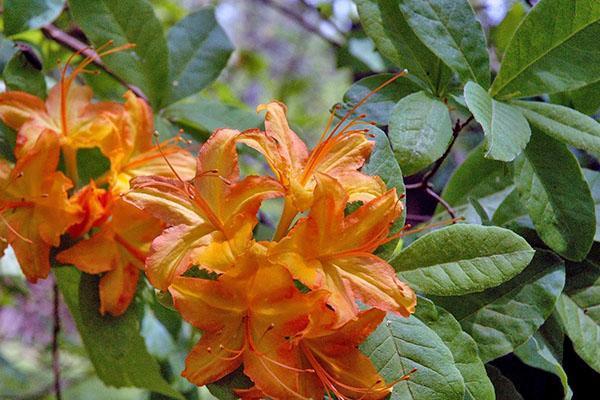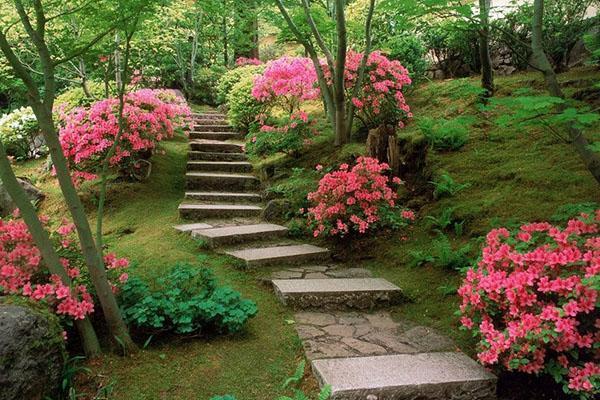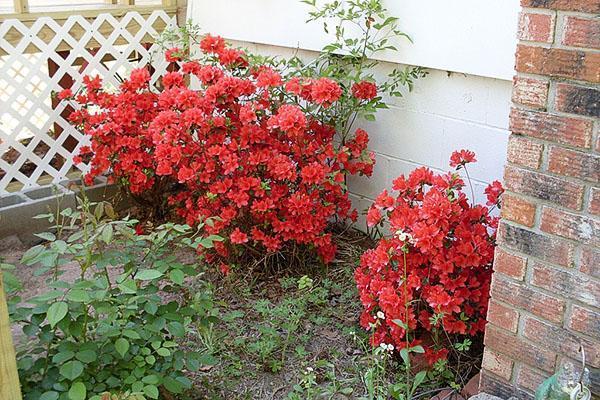Azalea garden: features of care and planting
 Garden azaleas or, as they are commonly called according to the modern classification of species, rhododendrons are a huge family of flowering shrubs that can seriously differ from each other in size, shades and shape of flowers and even lifestyle.
Garden azaleas or, as they are commonly called according to the modern classification of species, rhododendrons are a huge family of flowering shrubs that can seriously differ from each other in size, shades and shape of flowers and even lifestyle.
Numerous varieties and varieties of cultivated rhododendrons can:
- be evergreen and deciduous plants;
- reach a height of 3 meters and rise above the soil by only 50-60 cm;
- differ in terms of flowering.

Depending on the species and variety, you can enjoy a lush cloud of white, yellow, pink, lilac or purple flowers from three weeks to 2.5 months.
Deciduous varieties of garden azaleas have been successfully grown in Russia since pre-revolutionary times, and at the beginning of the last century they were actively used for landscaping and decorating parks near Moscow and St. Petersburg. Today, the selection work of botanists from all over the world has made it possible to easily select plants that, with good care, are very winter-hardy and bloom luxuriantly, grow in the middle lane.
On this topic:azalea home care after purchase video!
Growing conditions for garden azalea
 Azalea gardening refers to perennial plants with a fairly slow growth. This should be taken into account when choosing a place for planting a plant and organizing care for a young bush. For the first time, azaleas bloom only 3-4 years after planting, growing up and reaching full development.
Azalea gardening refers to perennial plants with a fairly slow growth. This should be taken into account when choosing a place for planting a plant and organizing care for a young bush. For the first time, azaleas bloom only 3-4 years after planting, growing up and reaching full development.
The ideal temperature for growing garden azaleas in the summer is 20-25 ° C, which is quite acceptable for most areas of the Russian middle zone. In winter, many varieties and hybrids can withstand temperatures as low as 27–32 ° C.
Yet the plant needs protection and year-round support. When planning the planting of a garden azalea, you need to be very careful about choosing a suitable place. In nature, rhododendrons are photophilous, but when exposed to direct sunlight:
- lose decorativeness faster;
- worse form flower buds;
- reduce flowering time.
Therefore, for azaleas, it is better to find a flat area protected from wind and flooding by spring waters in partial shade, where the bush will not suffer from summer heat, frost and gusts of cold air. For planting shrubs near the house, a north, east or west wall is suitable.
 Rhododendrons grow well in the vicinity of larger trees. True, it should be borne in mind that the roots of the plants do not interfere with each other. Spruces with a taproot system, small-leaved lindens and oaks feel good next to the garden azalea.
Rhododendrons grow well in the vicinity of larger trees. True, it should be borne in mind that the roots of the plants do not interfere with each other. Spruces with a taproot system, small-leaved lindens and oaks feel good next to the garden azalea.
For azaleas, it is useful to be adjacent to garden and park ponds. Here, thanks to the natural humidification of the air, the plant blooms for longer, and its foliage remains fresh.
Planting a garden azalea
The best time for transplanting or planting garden azaleas is early spring, when the plant has not begun a period of active sap movement.If for some reason rhododendrons are not planted at the beginning of the growing season, this can be done in September. For the remaining warm days and weeks, the shrub will have time to acclimatize and successfully overwinter.
 Azaleas growing outdoors have a superficial root system. Therefore, a deep planting hole for the shrub is not required, but the preparation of a loose fertile substrate is necessary:
Azaleas growing outdoors have a superficial root system. Therefore, a deep planting hole for the shrub is not required, but the preparation of a loose fertile substrate is necessary:
- The pit depth may not exceed 50 cm.
- In this case, the width should be 20-30 cm greater than the depth.
At the bottom, a powerful drainage layer is made from fragments of red brick, large expanded clay and sand. It is impossible to use limestone chips, since this mineral gradually changes the acidity of the soil and can cause withering and death of an already established garden azalea bush.
The soil removed from the planting pit is cleaned of turf, and then they add to it:
- cleaned from rough inclusions peat;
- humus;
- sand and other components necessary to ensure the looseness and structure of the substrate.
 Before plunging the seedling into the pit, a small amount of prepared soil is poured onto the drainage layer in the center. The roots of the bush are carefully laid out on it so that the root collar of the azalea, when backfilled, must remain above the soil level. The soil around the plant is compacted and moistened. If the soil has settled, it is poured, and the surface is abundantly mulched on top.
Before plunging the seedling into the pit, a small amount of prepared soil is poured onto the drainage layer in the center. The roots of the bush are carefully laid out on it so that the root collar of the azalea, when backfilled, must remain above the soil level. The soil around the plant is compacted and moistened. If the soil has settled, it is poured, and the surface is abundantly mulched on top.
If you plan to plant a garden azalea purchased from a nursery or store, its root system should first be revived by dipping it into water or watering abundantly before planting.
Seedlings with a closed root system are easier to transplant, while their roots do not need to be cleaned of existing soil, but it is worth checking the health of the roots and removing damaged ones.
Caring for your garden azalea after planting
 During the entire growing season, garden azaleas need abundant watering. Moisten the soil immediately after the surface layer has dried. Best for glaze rain or standing water is suitable. To maintain the increased acidity of the soil, citric or other food acid is added to the irrigation moisture once a month.
During the entire growing season, garden azaleas need abundant watering. Moisten the soil immediately after the surface layer has dried. Best for glaze rain or standing water is suitable. To maintain the increased acidity of the soil, citric or other food acid is added to the irrigation moisture once a month.
On hot days, in addition to the azalea flowering time, the shrubs can be sprayed with warm water to be a good support for the decorative effect of the shrub and as a prevention against insect pests and fungi.
At the end of summer, watering is reduced, provoking the completion of the growth of the shrub and improving its preparation for winter. For the same purpose, the application of dressings is stopped, especially if granular agents of prolonged action were used for this.
Caring for garden azalea includes mulching, which is designed to protect the roots of the plant from drying out in the summer and from frost in winter. Under such a shelter, weeds develop worse and more slowly, moisture is saved. A layer of mulch from needles, steamed sawdust or shavings, chopped cut grass or even fine expanded clay is replenished and restored as necessary, but does not cover the root collar of the plant.
It is impossible to support a flowering shrub with one watering. Therefore, the azalea is fed at least three times a year.
- In early spring, plants are watered with infusion of mullein or humus.
- Before the beginning of the azalea flowering time, except nitrogen, the shrub needs potassium and phosphorus in equal amounts.
- After wilting of most of the inflorescences, the plant is watered with a mixture of phosphorus and potassium fertilizers in a ratio of 1: 2.
Plants of garden azaleas are extremely negative about the introduction of fertilizers into the soil, which contain chlorine and lime. You should not use ash, which is popular with gardeners, for feeding.
Watering and feeding during the care of azaleas is carried out not under the root, but at a distance from the center of the bush at least 20 cm.This technique allows you to bring moisture and nutrients to the most active areas of the superficial root system of this garden culture.
Pruning azaleas in the garden
 The plant begins spring with already formed flower buds, therefore, after wintering, only sanitary pruning of azaleas is carried out in the garden, when dry and diseased shoots are removed.
The plant begins spring with already formed flower buds, therefore, after wintering, only sanitary pruning of azaleas is carried out in the garden, when dry and diseased shoots are removed.
Shrub formation is carried out after the flowers wither. During the procedure, both dry flower stalks and overly elongated branches are cut off. If you do not remove attention from pruning azaleas for several years, the bush gradually overgrows, the shoots block the access of light and air, which leads to the development of diseases and insect pests.
When pruning azaleas, it is important to remember that the buds are laid on annual shoots, so this year's growth is not affected. After pruning, large hemp is treated with garden pitch.
Young shrubs up to 3 years of age can not be formed, carrying out only the removal of dead shoots.
Winter azalea care
 Future flowering depends on the care of the azaleas throughout the year, as well as how the plant overwinters. Certain varieties of garden rhododendrons can survive Russian winters without shelter, but in this case it will not work to guarantee the health of the shrub:
Future flowering depends on the care of the azaleas throughout the year, as well as how the plant overwinters. Certain varieties of garden rhododendrons can survive Russian winters without shelter, but in this case it will not work to guarantee the health of the shrub:
- Flower buds at the ends of the shoots are the first to suffer from the cold.
- With a lack of snow, sometimes not only young branches, but also the root system freeze out.
To protect the plants, autumn begins preparing for winter with abundant watering of the soil under the bushes of garden azaleas. Then the root circle is covered with an additional layer of mulch, for which pine needles, peat or fallen leaves are taken. A layer of such protection for small plants can be 5-10 cm, up to 30 cm of insulation is poured under tall bushes.
Branches of deciduous varieties of azaleas growing in open ground:
- gently tilt to the soil;
- fixed with wire;
- covered with corrugated cardboard, special materials or another layer of spruce branches or peat.
It is not worth covering azaleas with foil or other airtight materials, since there is a high risk of developing rotting and rotting buds and young shoots.
Azalea evergreens are covered with a pre-made frame so as not to damage the shoots and future buds. Inside the shelter, the plant should not be constrained. And it is necessary to insulate the structure with roofing material or non-woven materials only in the established cool weather, if this is done on warm days, next spring it will not be possible to avoid the loss of some of the flowers.
 Caring for azaleas in winter is to protect plants from wind and moisture condensing during thaws. If the winter is with little snow, the bushes need to be additionally protected by creating man-made snowdrifts at their base. During the rainy season, azaleas are loosely covered with a film, leaving the possibility of moisture escape.
Caring for azaleas in winter is to protect plants from wind and moisture condensing during thaws. If the winter is with little snow, the bushes need to be additionally protected by creating man-made snowdrifts at their base. During the rainy season, azaleas are loosely covered with a film, leaving the possibility of moisture escape.
With the onset of spring, the shelter is removed only after the snow cover melts and the establishment of positive average daily temperatures.
During acclimatization and care of azaleas, they are constantly monitored to avoid sunburn of delicate tissues and wilting of the plant lacking nutrition and moisture.
Garden azaleas are a rewarding culture. Shrubs always respond with lush flowering and growth to adhere to the agrotechnology of growing azaleas in the garden and competent, regular care. No matter where the gardener lives, today you can find many amazing varieties of azaleas that have different colors and different flowering times.